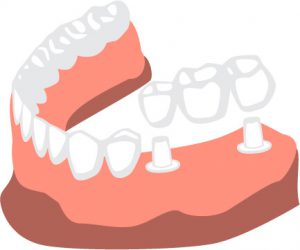Advantages of Dental Crowns and Bridges
By: Dr. Rajan Sharma

Dental crowns and bridges are popular tooth restoration options that have distinct advantages. A dental bridge is an artificial tooth or teeth, that span a gap in the mouth made by missing teeth. There are a few reasons someone might choose to have a dental bridge. They may have lost several teeth in an accident or due to decay. Unlike dentures, a dental bridge is a permanent attachment.
A dental crown is an artificial tooth that sits on top of a damaged tooth or dental implant. It gives the tooth its bite back, looks natural, and helps patients regain chewing abilities and their smiles. Crowns are used for teeth that are worn, cracked, or have a cavity too big to fill.
Benefits of Dental Bridge
A dental bridge helps improve appearance and confidence. When we can smile, we feel more confident. It also helps restore speech and chewing. Improved chewing allows for better digestion. Better eating results in better sleep which vastly improves our entire state of mind.

Different Types of Dental Bridges
There are four different types of dental bridges:
- Traditional
- Cantilever
- Implant support
- Maryland
The most common type of dental bridge is referred to as the traditional bridge. In this case, the artificial teeth are secured by dental crowns which are then cemented onto an abutment. This type of bridge fills the gap between natural teeth.
The cantilever dental bridge fastens the pontic (fake tooth) to the dental crown which is cemented to one abutment. Unlike the traditional bridge, this method needs only one natural tooth to be adjacent.
Similar to a traditional bridge in that it requires natural teeth on both sides, the Maryland dental bridge uses a metal or porcelain framework to bond with the abutments. This is perhaps the most stable form of dental bridge, but it does require a surgical procedure as the implants are fused to the jawbone.
Dental Crowns
Dental crowns, especially those made of porcelain, look like natural teeth. This makes them a popular choice. Apart from aesthetic reasons, they offer great protection for the underlying teeth. As a result, they are durable and can last up to 15 years if not more.
Types of Dental Crowns
Dental crowns are made with a few different materials, including the following:
- Stainless steel — This is a very common, cost-effective material for dental crowns especially for children who have a filling in their primary teeth.
- Metal — Metal crowns are durable and inexpensive. They are a good choice for molars at the back of the mouth where they aren’t as visible.
- Porcelain-fused-to-metal –– These crowns look like natural teeth but the porcelain covering can wear down easily. Once this happens the underlying metal is visible.
- All-resin dental crowns — This type of dental crown is inexpensive but do wear down and can crack more easily than other types.
- All-ceramic — This can include all-porcelain dental crowns, and provides the most natural look. They are a good choice for front teeth.
Schedule a checkup today!
The professionals at University Dental Associates are experts in all aspects of cosmetic dentistry including dental crowns and bridges. Schedule an appointment online today or call us at 800-250-3500.
